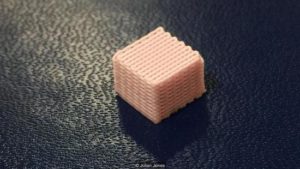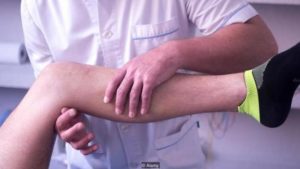The bio-glass was invented by American scientist Larry Hench in 1969. Hench invented this material from the dialogue with a colonel returned from the Vietnam War on the bus. Colonel told Hench that modern medical technology on the battlefield could save lives but could not save the body’s body. Hench decided to shelve his study of intercontinental ballistic missiles and to design biomimetic materials that would not be rejected by humans.
Glass does not seem to replace the common materials of human bones. But British surgeons have found that bio-glass is not only more robust than bones, but also flexible, can be bent, not susceptible to infection.
In 2002, Ian Thompson, a facial reconstruction specialist at King’s College London, received an emergency call. A 20-year-old patient was hit by a runaway car while walking on the road. Its head hit the front cover in the car, a huge impact hit his face, causing the eyes of the orbital floor fracture.
Orbital bone thickness of not more than 1mm, the main role is to fix the eye on the skull. Thompson explains: “The fragility of the orbital floor is a defensive mechanism for humans, but there is no orbital bottom, your eyes will move back to the skull, resulting in blurred vision and lack of focus.” The patient also lost the identification The ability to color. His job is to rewire the airplane, but the accident can no longer distinguish between the blue wire and the red wire. He was completely unable to work for three years.
Compared to the birth of new technology, the accident occurred three years earlier. In three years, the surgeon tried desperately to rebuild the orbital floor, pushing the eye back in place. The first is to use material implants, and then use the bones of the patient’s own ribs. Both surgery failed. Each month after a few months will be infected, causing the patient’s extreme pain. And now the doctor has the final solution.
Thompson’s mid-range solution is to create the world’s first glass implant, the biological glass made of a thin plate, from the patient’s eyes into the bottom of the orbital floor. The use of glass as a natural brittle material to repair such subtle things seems somewhat counterintuitive.
But this is not an ordinary glass.

“If you put an ordinary glass window in the human body, it will soon be surrounded by scar tissue, basically how long it will produce rejection.” But when you will be When the biological glass is placed in the body, it begins to dissolve and release ions, which are compatible with the human immune system and can be dissolved in cells. This means that the body does not think that this material is foreign, so it can be bonded to the bones and soft tissue, thereby stimulating the growth of new bones. ”
For Thompson, the effect of using new materials is instantly apparent. Almost in a moment, the patient to restore the vision, to identify the color, the sense of space is also back. Fifteen years have passed, his body is still very healthy.
Thompson has used bioglass to successfully cure more than 100 patients who have been hurt by a car or motorcycle accident. “Bioglass is actually much better than using the patient’s own bones,” Thompson said. “Because we have found that when the sodium in the biological glass dissolves, it slowly releases the sodium ions, which can kill the bacteria in the tissue, so in the occasional case, the bio-glass played such a mild antibiotic effect, Eliminate wound infection. ”
Frontier material
The bio-glass was invented by American scientist Larry Hench in 1969. Hench invented this material from the dialogue with a colonel returned from the Vietnam War on the bus. Colonel told Hench that modern medical technology on the battlefield could save lives but could not save the body’s body. Hench decided to shelve his study of intercontinental ballistic missiles and to design biomimetic materials that would not be rejected by humans.
Hench eventually brought his research to London. In the UK, orthopedic surgery to the field of dentistry, bio-glass application innovation is taking place.
Over the past decade, the surgeon uses powdered biological glass to repair the bony, which looks like sand and gravel, which can repair small cracks on the bones. Since 2010, the same powdery bio-glass has been popularized and used in a variety of toothpaste with dental restoration and protection. During the brushing process, the biol glass dissolves and releases calcium phosphate ions that are bound to the mineral. Over time, these substances can slowly stimulate the teeth to grow again.

But many scientists believe that the current application of bio-glass is only touched the surface of new materials. Researchers are using this new material to develop new clinical products that can completely alter the surgical procedures for bones and joints.
Julian Jones sat in his office in the Imperial College’s Materials Department, holding a small cube in his hand, which he called “elastic creature glass”. It resembles the current bioglass, but there are subtle changes: subtle changes in the chemical composition of the material make the other no longer fragile. But as Julian Jones said, “as the child in the hands of the elastic ball”, very flexible.
What is the ultimate replacement material for bones? Glass is the first choice
The key is that it can be implanted into bad legs. It not only supports the patient’s weight, allows them to walk freely without crutches, and does not require any additional metal or implant fixation. At the same time, this “elastic bio-glass” will also stimulate and guide the regeneration of human bones, while the material itself can be slowly and naturally absorbed into the body.
Julian Jones said: “In order to be able to make large bones in the fracture, the support of the material is very important.In addition, implanted in the legs of the implant to the weight of each bone cells to pass, it is very important Our body forms bones in its own structure because the cells are able to feel the weight of the human body, so it is necessary to pass the correct signal if you want a big bones to regenerate. An important reason for the slowing down of the astronauts in space astronauts is that there is no Gravity, the cells do not receive the same signal as gravity on earth.
A further change in the chemical composition of the biological glass makes the new material have a different character. It will become more soft, like rubber is generally full of toughness, can be used for cartilage repair.
Now, the surgeon repairs the damaged hip or knee cartilage through the joint microfracture. This involves removing the damaged cartilage from the damaged area and then piercing the bone to stimulate the bone marrow to release the stem cells and the stem cells grow into a smooth, rugged repair tissue with the blood clotting. However, this method may lead to scar cartilage, and in the same years the same problem.

As a solution, Julian Jones is trying to use 3D-printed bioglass to replace cartilage. In this case the material must retain all the natural properties of the cartilage. To test its effectiveness, Julian Jones developed a simulator using bio-glass.
“We are simulating the movement of the human body and bending everything in the knees and making sure that the bio glass can be like a true joint, and if everything goes well, we will carry out animal clinical trials,” he said.
This bio-glass can also be used to treat lumbar disc herniation. At present, the surgeon through the bone graft to replace the dysfunction of the disc to treat severe lumbar disc herniation. But while this eliminates the pain, but at the expense of flexibility. In contrast, the surgeon can use 3D-printed bioglass to replace the dysfunctional lumbar disc.
“It seems obvious,” Julian Jones said. “No one has ever been able to reproduce the characteristics of cartilage, but with bioglass, we think we can do that.”
“We can only prove that we can do it.If all goes well, we can pass all the necessary safety tests, which are expected to be used in clinical years”
Artificial new materials that can be integrated into the human body seem to be an important part of future medical care. Almost millions of people have used it to brush their teeth.
This may just start.
Leave a Reply